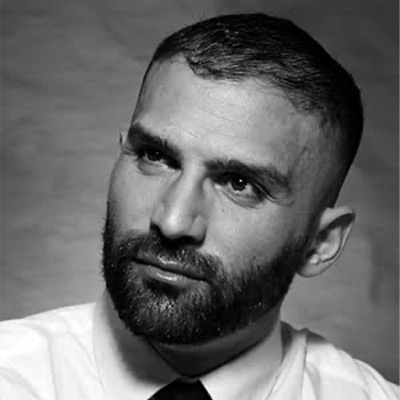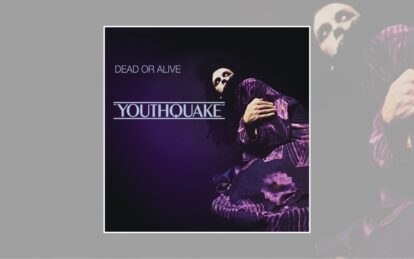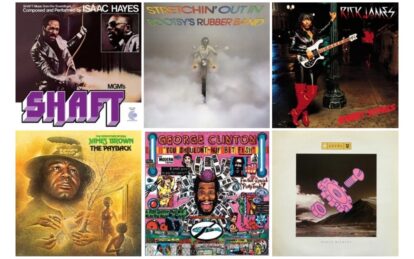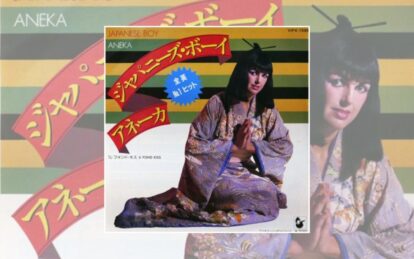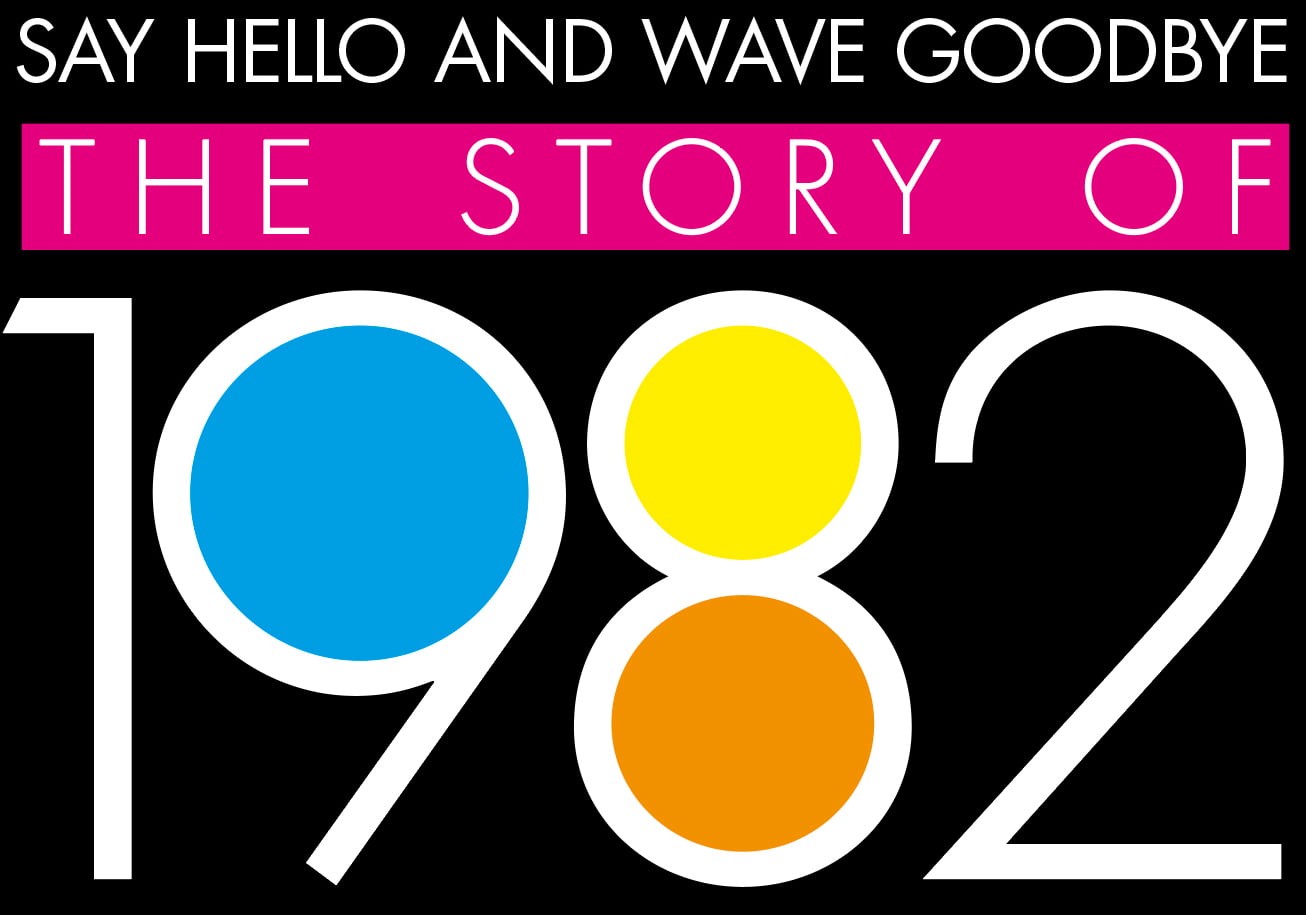
1982 in music
A trip down memory lane as we remember the best music of 1982…
Rumour has it, that Britain’s first new No.1 of 1982, Bucks Fizz’s Land Of Make Believe, was a clandestine anti-Thatcher rant with 1981’s Eurovision winners blindly oblivious to the songs intent.
Other signs of 1982’s oddness came that January, when Barry Manilow incurred the wrath of the Musicians’ Union touring the UK with a synth simulating orchestral parts. The Stranglers released a harpsichord-festooned waltz allegedly about heroin that would narrowly miss the top spot.
Somewhere on a stage in Iowa Ozzy Osbourne bit a head off a bat, and Noel Edmonds got so excited by Robert Palmer’s Some Guys he played it twice in a row. When Smash Hits’ editor David Hepworth, attempted to sum up the year he struggled. There were, he said, “no patterns” to pop in 1982.
One thing was clear, The Human League, 1981’s undisputed victors, were in an enviable position, going platinum, and breaking America while the re-released Being Boiled climbing to No.6. Another reissue, The Model, scored Kraftwerk a No.1. Clearly, synths would still be central to pop in 1982, with new models like the Roland SH-101 appearing.
For more on this brilliant year in pop music, buy our Classic Pop Presents 1982 special here.
It was ‘The Year of the Computer’ according to Time magazine; technology certainly helped Depeche Mode and Vince Clarke weather their break-up. Emerging keyboards like the PPG Wave gave the remaining band a fuller, fatter sound on A Broken Frame (January’s See You was their biggest hit yet). Similarly, the Roland Micro-composer, and the Fairlight CMI, became key tools for Vince Clarke in Yazoo, on Upstairs At Eric’s.
A No.2 smash, Upstairs At Eric’s was impressively eclectic, veering from tape experiments, gothic ballads (Winter Kills), super-funk (Situation) and deep, deep soul (Midnight). It boasted two mega-selling 45s too; electronic pop’s evergreen tear-jerker Only You and Don’t Go.
If Clarke’s gadgetry was Yazoo’s ice, then Alison Moyet’s ‘smoky, bluesy’ vocals was its fire. Crucially, Moyet, then simply Alf, wasn’t an Autobahn-clutching, bedroom boffin (her favourites were Billie Holliday and Ray Charles). She was equally at home on The Tube, duetting with Eric Burdon or providing backing vocals on labelmate Fad Gadget’s Under the Flag.
Marc Almond’s scorching delivery on 60s cover What? wasn’t the only human touch on Soft Cell’s three Top 5 hits in 1982. Acker Bilk-style clarinet introduced Say Hello Wave Goodbye’s 12-inch version, and jazzy trumpet raised Torch’s temperature. Acoustic guitars and funky bass ran through Bath duo Tears for Fears’ Pale Shelter.
Futurism fought with the funk on China Crisis singles like Scream Down At Me and album Difficult Shapes & Passive Rhythms; rubbery bass-lines and clattering percussion awash with Eno-esque textures. Closing ambient lullaby Jean Walks In Fresh Fields was another top-notch instrumental in the year of Vangelis’ epic Blade Runner score (as well as Mick Karn’s Sound Of Waves, Roxy’s India/Tara, and Soft Cell’s So).
Three Eurythmics singles were issued in 1982, initially imposing, avant-garde (This Is The House) they grew increasingly poppy (The Walk and November’s Love Is A Stranger). The new manifesto was ‘Kraftwerk meets Motown’, the new sounds were cascading omnichords, jazzy piano runs, bass and brass. There was a similarly expansive sound on Talk Talk’s The Party’s Over and Thomas Dolby’s Golden Age Of Wireless.
Inspiration was also coming from further East. Sitars and tablas adorned Blancmange’s Top 10 Living On The Ceiling and Monsoon’s Ever So Lonely, a No.12 for the 16-year-old Grange Hill actor Sheila Chandra and keyboardist Steve Coe; Monsoon also featured on Virgin’s The INDIPop CompilASIAN album.
Pushing hybridisation to creative extremes were two of the year’s art-rock masterpieces, Peter Gabriel 4 and Kate Bush’s The Dreaming, full of Fairlights, thunderous drums and ethnic rhythms (Bush opted for didgeridoos and Irish folk, Gabriel the Ghanaian rhythms of the Ekome Dance Company).
While Dare had done its job perfectly; it would be Heaven 17’s Penthouse And Pavement that seemed to shape 1982. Their British Electric Foundation (BEF) Music Of Quality And Distinction was only a modest success, but with its fingers on pop’s current pulse, reworking oldies electronically with an orchestra, reviving Tina Turner and Sandie Shaw.
For more on this brilliant year in pop music, buy our Classic Pop Presents 1982 special here.
Elsewhere, yesteryear’s stars repeated the formula: Twinkle, Alvin Stardust, Marty Wilde. But it was Midge Ure whose synth-heavy cover of No Regrets reached No.9, turning Walker Bros orch-pop into Vienna part two. And while Mari Wilson’s biggest hit Just What I Always Wanted wasn’t a 60s cover, the campy electro-vintage sure sounded like one. To go with it, was Mari’s hair, coiffured neatly, the singer was keen to stress, into “an 80’s beehive.”
Retro-modernity was at the heart of ABC’s (inevitable) success. “Poised to do very well in 1982,” wrote Mark Ellen in March’s Smash Hits, with its cover star resplendent in Vegas-style gold lamé. Critics applauded, single-buyers scooped up Poison Arrow, The Look Of Love and All Of My Heart.
That Summer, The Lexicon Of Love topped the album charts for a month. A ‘widescreen’ state-of-the-art production, Fairlights tangoed with ivories, bass-lines came from Moogs and men, while dickie-bowed strings ‘n’ horns soared over 808s, a Linn and the doof-doofs of a Simmons.
Bygone references abounded, lyrics summoned art-deco musicals, it came wrapped in a Powell/Pressburger-style Technicolour sleeve with old school sleeve notes. In ads, Fry-penned letters promising “a collection of songs for any season”. So far, so Sinatra. But wait, turn that sumptuous sleeve over. It was all staged, a fake.
Underneath the swooning romance, or “sentimental glop” as Fry called it, was an embittered anti-romantic, scarred from real heartbreak. Poison Arrow said it all; Cupid is a killer. Dollar and Gloria Gaynor may have been Lexicon Of Love’s building blocks but so was Love Will Tear Us Apart.
This was New Pop’s essence distilled; Pop tradition meeting post-punk sabotage (Love Is A Stranger also married Joy Division’s uneasy agony with I Feel Love’s ecstasy). ABC’s wild ambitions sprang from punk’s DIY ethics, right down to the self-choreographed ‘Smokey Robinson & The Miracles’ routine for Look Of Love on TOTP. It was the same spirit that catapulted Bananarama into the charts with Fun Boy Three (T’ain’t What You Do…, He Was Really Sayin’ Somethin’) and alone (Shy Boy).
The Lexicon Of Love wasn’t alone in hiding its lyrical claws under velvet gloves that year. Equally bittersweet, were Elvis Costello’s Imperial Bedroom and Joe Jackson’s Night And Day, a transatlantic hit that brought jazzy retro-elegance (vibes and piano) into the 80s with Korg synths and rhythm boxes. Night And Day’s title was a homage to the Cole Porter song that Everything But The Girl breezily covered that year.
Acts as disparate as Pigbag, Blue Rondo a la Turk and Rough Trade’s Weekend, plus Fun Boy Three’s Top 20 version of George Gershwin’s Summertime evidence a Jazz revival in full swing. Some of it even came from that year’s preppy boy wonders Haircut 100 on Love Plus One and Pelican West.
Much of The Lexicon Of Love’s ‘superhuman’ sheen came from Trevor Horn and his ace team: “Watch out” warned Smash Hits to 1981’s star producer Martin Rushent, and with good reason. Besides ABC, Horn supplied Dollar with his Midas touch on the 10cc-inspired Give Me Back My Heart, and Videotheque, while helping Malcolm McLaren bring Appalachian square dancing and Bronx hip-hop into the Top 10 with Buffalo Gals.
Other producers deployed similar tactics, sharpening manufactured Pop’s edge. Andy Hill did it with both Bucks Fizz’s second No.1 My Camera Never Lies and Bardo, Dollar-like UK Eurovision hopefuls (One Step Further came 7th in the competition, No.2 in the charts).
For more on this brilliant year in pop music, buy our Classic Pop Presents 1982 special here.
Bin-bag wearing all-girl Toto Coelo, plucked from Legs & Co. and the St Trinian’s cast, got a wild-wallop from Barry Blue on I Eat Cannibals. Sonic sophistication or the surreal kept the bland at bay from 1982’s cheesiest. Especially the spectacularly naff Tight Fit, whose Steve Grant was a preening Tarzan in the video for No.1 The Lion Sleeps Tonight. The producer behind this, and earworm Fantasy Island, was Tim Friese-Greene who’d later assist post-pop Talk Talk.
Tight Fit’s perma-tan ultra-pop jetting off for sunnier climes was just one example of British pop envisioning itself in a faraway location, away from rainy Blighty. 1982’s masters of this were Duran Duran. Rio’s videos had them swashbuckling in Sri Lanka one minute, debonair Anthony Price-suited yachtsmen in Antigua the next; split-screen editing glamorously echoing Dynasty/Dallas opening credits.
Read more: The story of 1981 in music
Read more: 10 best Human League songs
Unlike ABC, this was pure pleasure-seeking Pop Art, made clear from Playboy illustrator Patrick Nagel’s and Assorted Images’ cover artwork for the mega-selling Rio (Diana Ross went one better getting a Warhol of herself for Silk Electric). As if to remind people who got there first, Roxy Music released the exquisite chart-topping Avalon, in Bryan Ferry’s words, their most “romantic”, “escapist” music to date; dreaminess offset by a strong “groove factor”.
The title track’s video so closely resembled high-end advertising, you half expected a luxury product to appear at the end of it.
Spandau Ballet had a rockier year. Diamond missed the Top 10. “They’ve gone for artistic credibility and missed by a million miles,” said a “disappointed” Simon Le Bon. Deep cuts like Pharaoh scaled new heights, but the hits weren’t coming, and Gary Kemp wanted pop stardom, not cult status. Trevor Horn’s redo of Instinction reversed their fortunes, going Top 10.
That autumn they decamped to the Bahamas’ Compass Point, the studio of “sexy, exotic” blue-eyed soul for Gary Kemp. Before 1982 was over, Lifeline, the first fruit of their sun-soaked labour, was at a bounced-back No.7. In a foreign studio or video location, Duran and Spandau were fashioning themselves into global pop brands; international and tantalisingly out of reach. The aspirational 80s had truly arrived.
In this hyper-visual pop year, TV and film played huge roles. With Channel 4’s arrival came The Tube’s live-focused, cheekily presented chaos. TOTP’s choreographed hysteria revved up regardless, though John Peel now added irreverence. Beamed into living rooms afterwards were the kids from Fame; captivating the nation with stardom-seeking, leg warmer-wearing young Americans (Madonna auditioned). With it came Irene Cara’s No.1 theme, a No.1 album and hits High Fidelity and Starmaker.
Read more: Top pop songs of 1981
Read more: Top pop songs of 1982
In America’s new MTV-era, A Flock Of Seagulls hit big (I Ran went Top 10); then Wishing did likewise in Britain. The symbiosis between the screen and hit parade deepened. Survivor’s Eye Of The Tiger from Rocky III was one of Britain’s biggest-selling singles, while Fast Times At Ridgemont High paved the way for John Hughes’ teen movie/ace soundtrack combo. Bowie’s only new musical moves that year were tied to TV and cinema (Brecht’s Baal, and his Giorgio Moroder collab for Paul Schrader’s Cat People).
When music wasn’t on the screen, it was on the dancefloor. That summer both The Human League and Soft Cell issued remix albums, Love And Dancing and Non-Stop Ecstatic Dancing. London’s post-Blitz clubland spun in myriad directions; The Wag Club, Le Beat Route, and original goth haunt The Bat Cave, while Rusty Egan and Steve Strange opened the Camden Palace.
New Romantic traces remained, like the futurist-funk of Fashion’s Top 10 album Fabrique, the scene was splintering; New Sounds, New Styles, the magazine dedicated to covering it, folded that July. By November, Visage, Midge-less, had ditched the glam decadence of March’s The Anvil for the leather-clad Pleasure Boys. Clubbers began dressing down, a response in part to US dance-floor realism like Valentine Bros. Money’s Too Tight (To Mention). Meanwhile, Wham!, two schoolfriends from Bushey, released a defiant celebration of life on the dole, Wham Rap! and Young Guns (Go For It).
For more on this brilliant year in pop music, buy our Classic Pop Presents 1982 special here.
Disco was still a catch-all term for anything from ABC to the eclectic acts featured on 1982s K-Tel Disco Dancer compilation. From Boystown Gang to Odyssey, Britain bought it from America by the bucketload. Shalamar, featuring body-popping Jeffrey Daniel had three UK Top 10 singles; I Can Make You Feel You Good, A Night To Remember, and There It Is were THE modern disco sound; hard-edged, funk strewn with strobe-lit synths and sweeping strings.
Their Friends was one of NME’s best albums, a list topped by Marvin Gaye’s Midnight Love. Gaye’s Sexual Healing, Carly Simon’s Chic-assisted Why? showed veterans were staying dance-floor relevant. Meanwhile, Prince released four genre-busting sides on his breakthrough release 1999.
Everything seemed to be happening on the dance-floor, even the worst things. That year, Terry Higgins collapsed in London’s Heaven, becoming one of the UK’s earliest AIDS victims. Britain was also at war, engulfed in the Falklands conflict since April. Any single too topical or war-related was risky, and potentially dumper-bound; Blondie’s War Child, even Robert Wyatt’s poignant Shipbuilding wouldn’t chart until an 1983 reissue.
The Specials’ Ghost Town had been a state of the nation No.1 in ’81; this year, Fun Boy Three’s The More I See, broke a string of 1982 hits. The Damned’s Falklands-inspired Lovely Money slumped to No.42, while Captain Sensible’s Happy Talk, a jolly South Pacific cover, hit No.1.
Perhaps wisely, Madness kept Thatcher satire, Blue Skinned Beast, tucked away on The Rise & Fall, giving single-buyers the nutty boys they wanted on Driving In My Car and House Of Fun. Immune to all this were an increasingly political The Jam whose Town Called Malice was one of the year’s biggest sellers.
A great single didn’t need a big issue to flop, though; ABBA couldn’t buy a hit, with Head Over Heels, Under Attack or most criminally of all, The Day Before You Came. Frida’s There’s Something Going On hit elsewhere, but not in Britain.
That single’s producer, Phil Collins, found out nobody wanted to hear him playing your pervy, lonely neighbour on his weirdly wonderful Thru These Walls too. Out came the Motown for You Can’t Hurry Love, covers being a safer bet in such uncertain times. As was Mirage, Fleetwood Mac’s polished retreat from predecessor Tusk.
From McCartney’s Tug Of War to Steve Miller Band’s Abracadabra, many veterans did have a good year. But the giddy carousel of pop was spinning mercilessly fast, and nobody knew it more than Adam Ant. He started the year imperial, taking over TOTP for Goody Two Shoes and ended it barely scraping the Top 40.
Hiding in the League’s Mirror Man was an Ant portrait; pop’s Narcissus, lost in his reflection, fraught with “nagging doubt”. Anyone’s winning streak could end abruptly, from Gary Numan to Soft Cell, whose Where The Heart Is ended their run of super-hits.
Read more: The story of the New Romantics
Read more: Top 40 synth-pop songs
But anything could happen too. Clannad’s Harry’s Game theme and Japan’s Ghosts could haunt the top ten. Dexys could don dungarees and make Come On Eileen 1982’s biggest seller.
And Scotland’s Associates could sashay, gloriously, onto TOTP, for Party Fears Two, Club Country and 18 Carat Love Affair and feed the audience a chocolate Harrod’s guitar. May’s Sulk was deliriously great, a punch drunk Lexicon Of Love, or as singer Billy Mackenzie best put it: “ABBA meets Bet Lynch on acid”, his fearless vocal chords matched by Rankine’s filmic music.
Simple Minds’ New Gold Dream, released in September, surged with an against-all-odds optimism; Promised You A Miracle and Glittering Prize leapt into the charts, funkier, more radiant and hook-laden than ever. Less successful was Endgames’ We Feel Good but like Associates/Simple Minds, this was skywards Scottish pop.
By October, Rankine had quit Associates. Everyone, it seemed, was breaking up in 1982. Japan, The Teardrop Explodes, Linx. Some went AWOL; Blondie, ABBA, Roxy. Midge Ure left Visage, overworked with Ultravox’s Quartet, solo 45s, producing Phil Lynott and Cockney Rebel, co-directing videos for Bananarama, and exasperated by Steve Strange’s camel-riding antics (an elephant was unavailable).
The big split in 1982 was The Jam. Weller’s extra-curricular activities (his Jamming label), the string-soaked Bitterest Pill (No.2) and the stomping No.1, Beat Surrender, all suggested the trio couldn’t contain his ambitions. Amid 1982’s tumult, there were reflective ghosts in the ever-moving machine. Misty-eyed memories flooded pop, from Hot Chocolate’s It Started With A Kiss to Madness’ Our House (Rise & Fall’s original concept was childhood nostalgia).
There were elegies (McCartney’s Lennon tribute Here Today, The Pretenders mourning guitarist James Honeyman-Scott on Back On The Chain Gang); Even Kate Bush’s bank robber wistfully recalled a breezier, simpler time on There Goes A Tenner. The hottest new band, Culture Club’s Top 3 hit, Time (Clock Of The Heart) just wanted the world to slow down.
Not that Culture Club’s would. A melting pot of Black, Jewish, Gay and Essex cultures, their Kissing To Be Clever’s pick ‘n’ mix pop fused funk, Philly soul, lover’s rock, dub and synth. September’s breakthrough No.1 third single, Do You Really Want To Hurt Me also chimed with the reggae loving times
Image aside, Culture Club’s universal, communicative love songs were the real key to their success. A year earlier, Blitz’s former coat-check Boy George declared “the ice age is over.” It seemed Paul Weller’s favourite singer that year was absolutely right.
1982’s festive chart-topper was a duo, but not a synth was in sight for Renee and Renato’s Save Your Love, ending a year awash with MOR ballads, some of them old (Charlene’s I’ve Never Been To Me), some exquisite (Dionne Warwick’s Heartbreaker) while The John Lennon Collection sat atop the album charts.
All year, record buyers had clung to the past, while so many of the year’s best zoomed into tomorrow, from New Order’s Temptation, to Heaven 17’s 303- bubbling Let Me Go! And the deconstructed soul of Scritti Politti’s Faithless.
But then, 1982 had been a year where nothing had been what it seemed. You really had to take Martin Fry’s advice, and look below the surface. If you did, you’d see little clues of where 1983 was heading, from The The’s Uncertain Smile, to Michael Jackson’s Thriller, already on the record shelves, and patiently waiting to eclipse everybody.
For more on this brilliant year in pop music, buy our Classic Pop Presents 1982 special here.
Read more: Top 20 Adam Ant songs
Read more: Kate Bush – album by album
Classic Pop may earn commission from the links on this page, but we only feature products we think you will enjoy.

